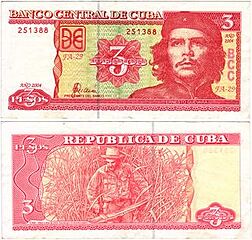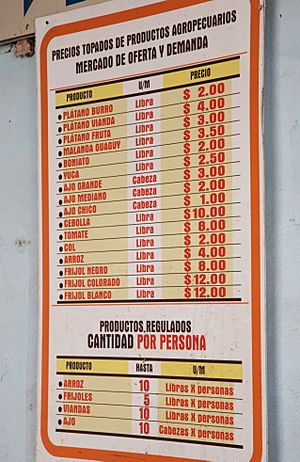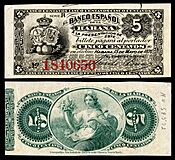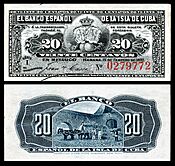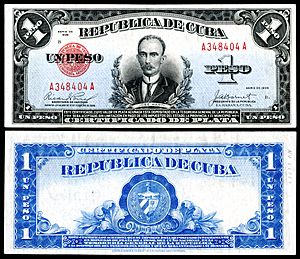Cuban peso facts for kids
Quick facts for kids Cuban peso |
|||
|---|---|---|---|
|
|||
| ISO 4217 Code | CUP | ||
| User(s) | |||
| Pegged with | US$ = 24 CUP (official) US$ = 120 CUP (CADECA office exchange rate in Cuba) |
||
| Subunit | |||
| 1⁄100 | centavo | ||
| Symbol | $ | ||
| centavo | ¢ or c | ||
| Coins | 1¢, 2¢, 5¢, 20¢, $1, $3, $5 | ||
| Banknotes | $1, $3, $5, $10, $20, $50, $100, $200, $500, $1,000 | ||
The Cuban peso (called peso cubano in Spanish) is the official money of Cuba. It is also known as moneda nacional, which means "national currency." Its official code is CUP.
For a long time, the Cuban peso was linked to other important currencies. From the 1500s to the 1800s, it was worth the same as the Spanish dollar. Then, from 1881 to 1959, it was worth the same as the U.S. dollar. After 1959, the Cuban government changed its economic system. It then linked the peso to the Soviet ruble, which was the money of the Soviet Union.
When the Soviet Union broke apart in 1991, Cuba faced tough economic times. This period was called the Special Period. From 1994 to 2020, Cuba used two different currencies. One was the Cuban peso (CUP). The other was the Cuban convertible peso (CUC). The CUC was linked to the U.S. dollar. For most people, 1 CUC was worth 1 U.S. dollar, and 1 CUC was worth 25 Cuban pesos (CUP).
However, government businesses had a different exchange rate. They could exchange CUPs for CUCs or U.S. dollars at a special rate. For them, 1 U.S. dollar was equal to 1 CUC, and 1 CUC was equal to just 1 CUP. This created two different money systems in Cuba.
On January 1, 2021, Cuba made a big change. They got rid of the Cuban convertible peso (CUC). The Cuban peso (CUP) became the only official money in Cuba. All CUCs were exchanged for CUPs at a rate of 24 CUP for every 1 CUC. A single official exchange rate was set: 24 CUP for 1 U.S. dollar. This rate was for everyone, both regular people and businesses. But because there wasn't enough foreign money, people often had to pay much more for U.S. dollars on the unofficial market.
History of the Cuban Peso
Early Money in Cuba (Before 1994)
Before 1857, people in Cuba used Spanish money called reales. In 1857, Cuba started printing its own banknotes. These were called pesos, and each peso was worth 8 reales. Later, in 1869, they also started using centavos, with 100 centavos making up 1 peso.
In 1881, the Cuban peso was set to be worth the same as the US dollar. For many years, Cuba only used paper money. The first Cuban coins were not made until 1915.
In 1960, the value of the peso changed. This happened after the United States stopped trade with Cuba. Fidel Castro then changed Cuba's economy. He made the Soviet Union Cuba's main economic partner. The Cuban peso was then linked to the Soviet ruble.
During this time, the government controlled all foreign money. Regular people could not buy foreign money with Cuban pesos. Instead, visitors used special coins from the National Institute of Tourism (INTUR) or special certificates from the National Bank of Cuba. These were used to buy special goods that were not available with regular Cuban money.
Two Currencies (1994-2020)
When the Soviet Union broke up in 1991, Cuba faced a difficult time. They needed foreign money to buy things like oil. In 1993, the U.S. dollar was allowed to be used in Cuba. This was to encourage more foreign money to come into the country. At this time, the Cuban peso lost a lot of its value.
In 1994, the Cuban convertible peso (CUC) was introduced. It was worth the same as the US dollar and was used alongside it. Over time, the Cuban peso became more stable. Its value was set at 25 CUP for 1 CUC or 1 US dollar. This rate was available to the public at exchange offices called Cadecas.
In 2004, the CUC replaced the U.S. dollar as legal money in Cuba. The CUC was still linked to the dollar. If you changed U.S. dollars to CUCs, there was a 10% fee. You could avoid this fee by exchanging other types of money.
After 2000, Cuba's economy became more stable. This allowed the government to bring back some parts of its planned economy. This meant the government sold some goods at very low, subsidized prices. This system used different exchange rates:
- Government-owned businesses used an official rate where 1 US dollar was equal to 1 CUC, and 1 CUC was equal to just 1 CUP.
- This allowed them to sell subsidized goods to people who earned salaries in CUPs. For example, someone earning 500 CUPs a month (worth about 20 US dollars at the public exchange rate) could buy goods that would normally cost 500 US dollars.
- The government also set different exchange rates for different types of businesses.
- Cuban government workers were paid mostly in CUPs, but sometimes got extra money in CUCs for good work.
This complex system of different exchange rates had some effects:
- Government companies did not have a strong reason to earn foreign money.
- The CUC was not truly backed by foreign money. It could be printed easily. So, neither the CUC nor the CUP could be used or bought outside Cuba.
- Cuba's economy was like a "dual-track" system. Most people earned only CUPs and relied on cheap, subsidized goods. A smaller group earned more money in CUCs or foreign money by working with tourists.
- Shops also had "dual-track" prices. Basic goods were sold in CUPs. Imported or luxury goods were sold in CUCs, often at much higher prices for tourists.
- The different values of the U.S. dollar (1 CUP, 10 CUP, or 25 CUP) created chances for people to make unfair profits.
This complicated system caused problems for both the government and the public. In 2013, the government said it planned to get rid of the multiple exchange rates and the CUC. While they prepared for this, many businesses started accepting both CUPs and CUCs at a rate of 25 CUP for 1 CUC. New, higher-value CUP banknotes (200, 500, and 1000 pesos) were also introduced. The change was delayed for several years because of worries about how it would affect government businesses. But by 2020, with fewer tourists due to the COVID-19 pandemic, the government could no longer afford to sell subsidized goods and dollars.
One Currency (2021)
On December 10, 2020, Cuba announced that the "Day Zero" of monetary unification would happen on January 1, 2021. This meant there would be only one official exchange rate: 24 CUP for 1 U.S. dollar. This rate would apply to everyone. The Cuban Convertible Peso (CUC) was removed from use and could be exchanged for CUPs at a rate of 24 CUP for 1 CUC until the end of 2021.
For government businesses, this was like a devaluation, meaning their money was officially worth less. But for regular people, it just meant that government businesses were finally using the same exchange rate that had been common in the private market for a long time.
Inflation in Cuba
In 2021, it became very hard for people and businesses to exchange CUP for U.S. dollars at the official rate of 24 CUP/USD. This was because there was a shortage of foreign money. This led to a black market for currency exchange. By January 2022, 1 U.S. dollar was worth about 100 CUP on this unofficial market. The price of one U.S. dollar reached 200 CUP in October 2022, and 300 CUP in February 2024. This means the Cuban peso lost a lot of its buying power.
Coins of Cuba
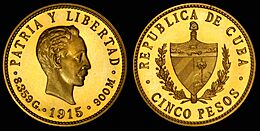
Coins Before 1959
In 1897 and 1898, revolutionary groups fighting for Cuba's independence made their own peso coins. In 1915, Cuba introduced many new coins. These included 1, 2, and 5 centavos made of copper-nickel. Silver coins were made for 10, 20, and 40 centavos, and 1 peso. Gold coins were also made for 1, 2, 4, 5, 10, and 20 pesos. These coins were designed by Charles E. Barber, who also designed U.S. coins. They were made at the U.S. Mint in Philadelphia.
After 1916, gold coins and 2 centavos were no longer made. The large star 1 peso coin stopped being made in 1934. A new silver peso, called the "ABC peso," was made from 1934 to 1939. It showed a woman representing the Cuban Republic. In 1953, a special peso coin was made to celebrate 100 years since Jose Marti's birth.
Brass 1 and 5 centavo coins were made in 1943. Copper-nickel coins were made off and on from 1915 to 1958. The last 10, 20, and 40 centavo coins were made in 1952. These were special coins celebrating 50 years of the Cuban Republic. In 1953, silver 25 and 50 centavo coins were also made. These were the last silver coins used for everyday buying. The last coin made in the U.S. for Cuba was the 1961 five centavo piece.
Coins After 1959
In 1962, new 20 and 40 centavo coins were introduced. In 1963, 1 and 5 centavo coins made of aluminum came out. In 1969, aluminum 20 centavo coins were made. In 1983, aluminum 2 centavo coins and brass 1 peso coins were introduced.
In 1990, copper-nickel 3 peso coins were made. In 1992, 1 peso coins made of brass-plated steel and 3 peso coins made of nickel-clad steel followed. The 40 centavo coins were removed from use around 2004. In 2017, the Central Bank of Cuba introduced new 5 peso coins. These coins are made of two different metals.
Today, the coins commonly used are 5 and 20 centavos, and 1, 3, and 5 pesos. The 1 and 2 centavo coins are rarely seen because they are worth so little, but they are still valid.
| Image | Value | Technical details | Description | First made | |||||
|---|---|---|---|---|---|---|---|---|---|
| Diameter | Thickness | Mass | Material | Edge | Front side | Back side | |||
| 1 centavo | 16.76 mm | 1.4 mm | 0.75 g | Aluminium | Smooth | Coat of arms of Cuba, "REPUBLICA DE CUBA", "UN CENTAVO" | "PATRIA Y LIBERTAD" (Fatherland and Liberty) or "PATRIA O MUERTE" (Fatherland or Death), Roman numeral "I" in a star, date | 1963 | |
| 2 centavos | 19.31 mm | 1.7 mm | 1 g | Aluminium | Smooth | Coat of arms of Cuba, "REPUBLICA DE CUBA", "DOS CENTAVOS" | "PATRIA O MUERTE" (Fatherland or Death), Roman numeral "II" in a star, date | 1983 | |
| 5 centavos | 21.21 mm | 1.81 mm | 1.5 g | Aluminium | Smooth | Coat of arms of Cuba, "REPUBLICA DE CUBA", "CINCO CENTAVOS" | "PATRIA Y LIBERTAD" (Fatherland and Liberty) or "PATRIA O MUERTE" (Fatherland or Death), Roman numeral "V" in a star, date | 1963 | |
| 20 centavos | 24 mm | 2.15 mm | 2 g | Aluminium | Smooth | Coat of arms of Cuba, "REPUBLICA DE CUBA", "VEINTE CENTAVOS" | "PATRIA O MUERTE" (Fatherland or Death), Roman numeral "XX" in a star, date | 1969 | |
| 1 peso | 24.5 mm | 1.9 mm | 5.52 g | Brass-plated steel | Segmented reeding | Coat of arms of Cuba, "REPUBLICA DE CUBA", date | "PATRIA O MUERTE" (Fatherland or Death), portrait of José Martí | 1992 | |
| 3 pesos | 26.5 mm | 9 g | Copper-nickel | Reeded | Coat of arms of Cuba, "REPUBLICA DE CUBA", "TRES PESOS" | "PATRIA O MUERTE" (Fatherland or Death), portrait of Che Guevara | 1992 | ||
| 5 pesos | 25.3 mm | 2.27 mm | 7.5 g | Brass-plated steel center in a Copper-nickel-plated steel ring | Reeded | Coat of arms of Cuba, "REPUBLICA DE CUBA", "CINCO PESOS" | "PATRIA O MUERTE" (Fatherland or Death), portrait of Antonio Maceo | 2016 | |
INTUR Coins (1981-1989)
From 1988 to 1989, the National Institute of Tourism (INTUR) made special "Visitors' Coinage" for tourists. These coins were in denominations of 5, 10, 25, and 50 centavos, and 1 peso. In 1988, they also made aluminum 1, 5, 10, 25, and 50 centavos. These INTUR coins were stopped on October 15, 2001. They were replaced by the convertible pesos (CUC).
CUC Coins (1994-2020)
The convertible peso (CUC) was also divided into 100 centavos. In 1994, coins were made for 5, 10, 25, and 50 centavos, and 1 peso. These were made of nickel-plated steel. A rare 5-peso coin, made of two different metals, was introduced in 1999. A 1-centavo coin followed in 2000. These CUC coins were used alongside CUP coins. You could tell them apart by their color (CUCs were mostly nickel-plated steel, CUPs were aluminum or brass) and by the octagonal shape around the edge of all CUC coins.
Banknotes of Cuba
|
|
|
|
|
|
|
|
|
|
Banknotes Before 1959
The first Cuban banknotes were issued in 1857 by the Spanish Bank of Havana. These were in large amounts like 50, 100, 300, 500, and 1,000 dollars. Later, in 1867, 25 peso notes were added, and in 1869, 5 and 10 peso notes. During the Ten Years' War, notes were issued by the Republic of Cuba.
In 1872, the Spanish Bank of Havana introduced notes for smaller amounts: 5, 10, 25, and 50 centavos, and 1 and 3 pesos. In 1891, the Treasury issued notes for 5, 10, 20, 50, 100, and 200 pesos. In 1896, the bank's name changed. It then issued notes in many different amounts.
In 1934, the government started issuing "silver certificates." These were notes that could be exchanged for silver. They came in amounts of 1, 5, 10, 20, and 50 pesos. Later, 100 pesos were added in 1936, and 500 and 1000 pesos in 1944.
Silver Certificates
Cuba created laws in 1933 to make silver certificates. These Cuban silver certificates were designed and printed in the U.S. from 1934 to 1949. They were used in Cuba between 1935 and the early 1950s. There were eight different series of these notes, ranging from one peso to 100 pesos. A Cuban representative worked with the U.S. to approve the designs.
National Bank of Cuba (Banco Nacional de Cuba)
In 1949, the National Bank of Cuba started printing paper money again. They introduced notes for 1, 5, 10, and 20 pesos that year. In 1950, they added notes for 50, 100, 500, 1000, and 10,000 pesos. However, notes higher than 100 pesos were not continued.
When Cuba changed to a socialist planned economy, the National Bank stopped using all old banknotes on August 7, 1961. They replaced them with new banknotes printed in Czechoslovakia. This change was announced just a few days before. Only people living in Cuba could exchange small amounts of old money for new money on August 6 and 7. A three-peso note was introduced in 1983.
Central Bank of Cuba (Banco Central de Cuba)
In 1997, the jobs of the National Bank, like printing money, were given to a new organization. This new organization is the Central Bank of Cuba. It is the main economic center in Cuba.
The 1961 banknotes were stopped on May 1, 2002. New 200, 500, and 1000 peso notes were introduced in 2015. Today, the banknotes used are 1, 3, 5, 10, 20, 50, 100, 200, 500, and 1000 pesos. These are the only valid banknotes after the money system was unified in 2021.
| Value | Front side | Back side |
|---|---|---|
| 1 peso | José Martí | Fidel Castro and his men entering Havana (January 8, 1959) |
| 3 pesos | Ernesto Guevara ("Che") | "Che" Guevara cutting sugar cane |
| 5 pesos | Antonio Maceo | Meeting between Antonio Maceo and Spanish General A. Martinez Campos (1878) |
| 10 pesos | Máximo Gómez | "War of the people" |
| 20 pesos | Camilo Cienfuegos | Banana harvest and farm work |
| 50 pesos | Calixto García Íñiguez | Genetic and Biotechnological Centre |
| 100 pesos | Carlos Manuel de Céspedes | Anti-imperialistic tribune "José Martí" in Havana |
| 200 pesos | Frank País | Moncada Barracks in Santiago de Cuba |
| 500 pesos | Ignacio Agramonte | Constituent Assembly in Guáimaro |
| 1,000 pesos | Julio Antonio Mella | University of Havana |
Foreign Exchange Certificates (1985)
In 1985, the National Bank of Cuba issued special foreign exchange certificates. These were in amounts of 1, 3, 5, 10, 20, 50, and 100 pesos. They were not the same as the regular Cuban peso (CUP). After 1994, these were replaced by the CUC, or convertible peso.
CUC Banknotes (1994-2020)
From 1994 to 2020, the National Bank of Cuba and the Central Bank of Cuba issued CUC banknotes. These came in amounts of 1, 3, 5, 10, 20, 50, and 100 pesos. These CUC banknotes were used alongside CUP banknotes. Even though their values were very different (25 CUP for 1 CUC), you could tell them apart. CUC notes showed pictures of monuments, while CUP notes showed portraits of people.
Exchange Rates
The exchange rates from commercial banks are shared on the Facebook page of the Cuban bank, Banco Metropolitano.
| Current CUP exchange rates | |
|---|---|
| From Google Finance: | AUD CAD CHF EUR GBP HKD JPY USD EUR JPY USD |
| From Yahoo! Finance: | AUD CAD CHF EUR GBP HKD JPY USD EUR JPY USD |
| From XE.com: | AUD CAD CHF EUR GBP HKD JPY USD EUR JPY USD |
| From OANDA: | AUD CAD CHF EUR GBP HKD JPY USD EUR JPY USD |
| From fxtop.com: | AUD CAD CHF EUR GBP HKD JPY USD EUR JPY USD |
See also
 In Spanish: Peso cubano para niños
In Spanish: Peso cubano para niños
- Cuban convertible peso
- Central banks and currencies of the Caribbean
- Economy of Cuba
- Demurrage (currency)


